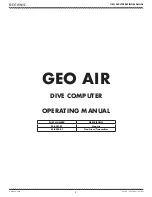
MGL Avionics Stratomaster Ultra Horizon XL Owner’s manual
Page 43
The VSI indicator
The VSI (vertical speed indicator) shows your rate of sink or climb.
Readout is in feet per minute or meters per second depending on your choice of altitude units.
You have four different display options for the VSI.
The traditional analog VSI. This provides you with an analog range of +/- 2000
ft per minute (or the equivalent in meters per second) plus a digital readout to
+/-9999 ft/minute.
Two VSI options are provided, designed to be placed on top of the altimeter
tapes. One version is provided for a left and one of a right bias tape altimeter
display.
For applications needing to save display space, a compact numeric only VSI
readout can be selected.
This image shows a tape based altimeter with correctly applied VSI
readout.
Further to this the glide/climb ratio indicator is shown together with the
matching “GCR” label.
Glide/climb ratio shows you the ratio between your forward airspeed (true
airspeed) and your vertical speed.
This indication is a useful feature to optimize your aircrafts glide slope.
A “VSI” label is available as well as a VSI units readout that displays either
“fpm” or “mps” depending on your chosen altimeter units.
The VSpeed indicator
The Ultra provides a VSpeed indicator. This instrument shows your airspeed (ASI) in
relation to your defined VSpeeds. You can define the following VSpeeds in the Basic
operation setup menu.
Vs – stall speed, minimum operating speed with full flaps deployed.
Vf – maximum flap speed.
VNo – maximum maneuvering speed.
VNe – maximum allowable straight and level airspeed.
Your airspeed in relation to the VSpeeds is indicated by the position of a horizontal bar.
The VSpeed indicator would normally be used with conventional three axis controlled aircraft.
This display is of lesser value in weight shift aircraft such as trikes and of little value in Rotor craft.
If you would like to use the VSpeed indicator, we recommend to place it next to the airspeed
indicator.
















































